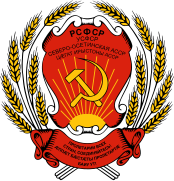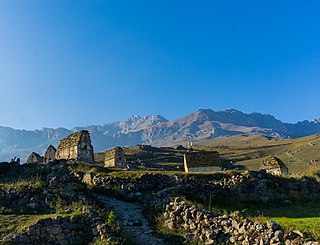
The Republic of North Ossetia–Alania is a republic of Russia situated in the North Caucasus of Eastern Europe. Its population according to the 2010 Census was 712,980. Its capital is the city of Vladikavkaz. The republic's native Ossetians speak Ossetian, one of the few Iranian languages spoken in Europe.

The Mountain Autonomous Soviet Socialist Republic or Mountain ASSR was a short-lived autonomous republic within the Russian SFSR in the Northern Caucasus that existed from 20 January 1921, to 7 July 1924. The Mountainous Republic of the Northern Caucasus was created from parts of the Kuban and Terek Oblasts by the indigenous nationalities after the Russian Revolution; however, Soviet rule was installed on this territory after the Red Army conquered the Northern Caucasus in the course of the Russian Civil War, and the former republic was transformed into a Soviet one. The area of the republic was over 73,000 square kilometres (28,000 sq mi), and the population was about 800,000. It comprised six okrugs: Balkar, Chechen, Kabardian, Karachay, Nazran (Ingushetia), and Vladikavkaz Okrug (Ossetia) and had two cities: Grozny and Vladikavkaz. In addition, a special autonomy was provided to the Terek Cossacks: Sunzha Cossack Okrug, which included a large enclave in northern Ingushetia, and a smaller one bordering Grozny. Its boundaries approximated those of classical Zyx.
An Autonomous Soviet Socialist Republic was a type of administrative unit in the Soviet Union (USSR) created for certain nations. The ASSRs had a status lower than the constituent union republics of the USSR, but higher than the autonomous oblasts and the autonomous okrugs.
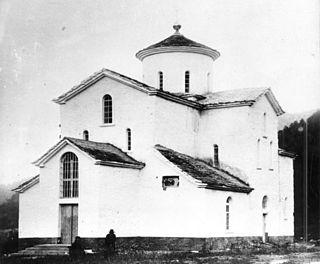
The Republic of North Ossetia – Alania is a federal subject of Russia, located in the Caucasus region.
Autonomous oblasts of the Union of Soviet Socialist Republics were administrative units created for a number of smaller nations, which were given autonomy within the fifteen republics of the USSR.

The coat of arms of the Kazakh Soviet Socialist Republic was adopted on March 26, 1937, by the government of the Kazakh Soviet Socialist Republic. The coat of arms is based on the coat of arms of the Soviet Union.

The coat of arms of the Kirghiz Soviet Socialist Republic was adopted on March 23, 1937, by the government of the Kirghiz Soviet Socialist Republic. The coat of arms is based on the coat of arms of the Soviet Union. It shows symbols of agriculture on a backdrop of the Ala-Too mountain ranges, surrounded by a frame of folk art of the Kyrgyz people. The red star was added in 1948. The rising sun stands for the future of the Kyrgyz nation, the star as well as the hammer and sickle for the victory of communism and the "worldwide socialist community of states".
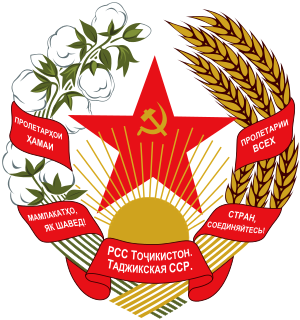
The State Emblem of the Tajik Soviet Socialist Republic was adopted on March 1, 1937 by the government of the Tajik Soviet Socialist Republic. The emblem is based on the State Emblem of the Soviet Union. It shows symbols of agriculture. The red star is prominently featured with a small hammer and sickle within it. The rising sun stands for the future of the Tajik nation, and the star as well as the hammer and sickle for the victory of communism and the "world-wide socialist community of states". The emblem was replaced with the new emblem in 1992, which uses a similar design to the Soviet one. It was, however, was replacing the red banner with the current national flag, the big red star was replaced by the mountains, represents Pamir, the Samanid dynasty crown, and added the Quran book at below. It represents Islam as the official religion.

South Ossetia is a region in the North Caucasus that is under the effective control of the self-declared Republic of South Ossetia–the State of Alania but recognized by most of the international community as part of Georgia. The Government of Georgia has established a Provisional Administration of South Ossetia which it considers to be the legal government of South Ossetia. Both entities have adopted a similar flag to represent themselves, a tricolour, top to bottom white, red, and yellow.
South Ossetia is a region in the North Caucasus that is under the effective control of the self-declared Republic of South Ossetia–the State of Alania but recognized by most of the international community as part of Georgia. The Government of Georgia has established a Provisional Administration of South Ossetia which it considers to be the legal government of South Ossetia.

The emblem of the Russian Soviet Federative Socialist Republic (RSFSR) was adopted on 10 July 1918 by the government of the Russian Soviet Federative Socialist Republic, and modified several times afterwards. It shows wheat as the symbol of agriculture, a rising sun for the future of the Russian nation, the red star as well as the hammer and sickle for the victory of Communism and the "world-wide socialist community of states".
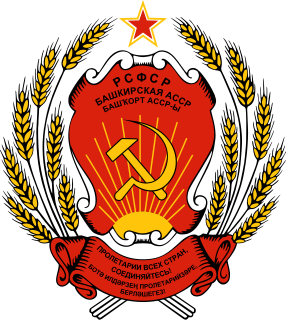
The national emblem of the Bashkir Autonomous Soviet Socialist Republic was adopted in 1937 by the government of the Bashkir Autonomous Soviet Socialist Republic. The device is based on the emblem of the Soviet Union.
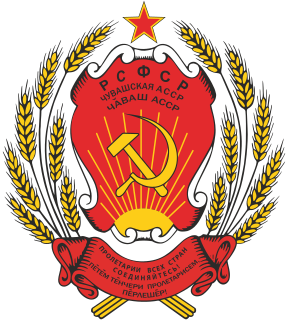
The national emblem of the Chuvash Autonomous Soviet Socialist Republic was adopted in 1937 by the government of the Chuvash Autonomous Soviet Socialist Republic. The emblem is identical to the emblem of the Russian Soviet Federative Socialist Republic.

The emblem of the Komi Autonomous Soviet Socialist Republic was adopted in 1938 by the government of the Komi Autonomous Soviet Socialist Republic. The emblem is identical to the emblem of the Russian Soviet Federative Socialist Republic.
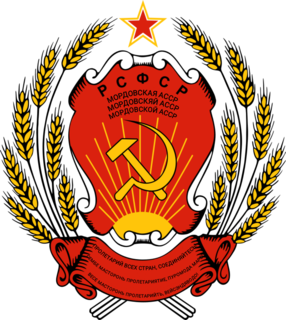
The national emblem of the Mordovian Autonomous Soviet Socialist Republic was adopted in 1937 by the government of the Mordovian Autonomous Soviet Socialist Republic. The emblem is identical to the emblem of the Russian Soviet Federative Socialist Republic.
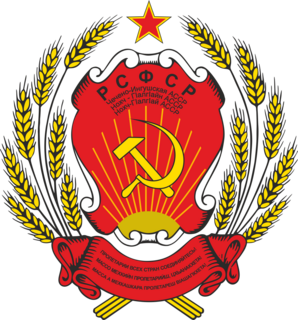
The national emblem of the Checheno-Ingush Autonomous Soviet Socialist Republic was adopted in 1937 by the government of the Checheno-Ingush Autonomous Soviet Socialist Republic. The emblem is identical to the emblem of the Russian Soviet Federative Socialist Republic.

The national emblem of the North Ossetian Autonomous Soviet Socialist Republic was adopted in 1940 by the government of the North Ossetian Autonomous Soviet Socialist Republic. The emblem is identical to the emblem of the Russian Soviet Federative Socialist Republic.

The national emblem of the Udmurt Autonomous Soviet Socialist Republic was adopted in 1937 by the government of the Udmurt Autonomous Soviet Socialist Republic. The emblem is identical to the emblem of the Russian Soviet Federative Socialist Republic.

The flag of the North Ossetian Autonomous Soviet Socialist Republic was adopted in 1954 by the government of the North Ossetian Autonomous Soviet Socialist Republic. The flag is identical to the flag of the Russian Soviet Federative Socialist Republic.

The coat of arms of the Sakha Republic, in the Russian Federation, is an official symbol of the Sakha Republic, alongside the flag and the national anthem of the Sakha Republic. The coat of arms consists of a circle, in the center of which is a red silhouette of a rider, holding a banner, mounted upon a six-legged horse, based on the prehistoric petroglyphs of the "Shishkin pisanitsa", against a white sun background. The central image is framed with a traditional Sakha ornament in the form of seven rhombic crystal-like figures and the inscriptions "Республика Саха (Якутия) • Саха Өрөспүүбүлүкэтэ". This coat of arms has been used officially since 26 December 1992.



